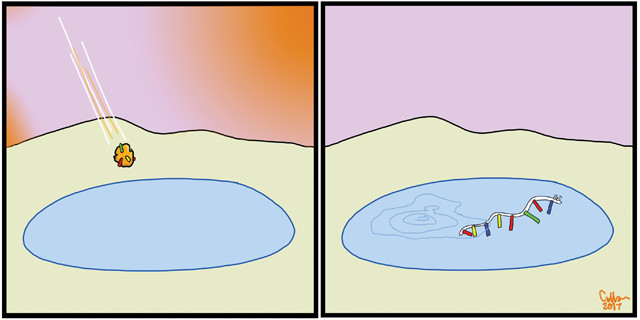
by Mary Caperton Morton Tuesday, January 9, 2018

If a meteorite bearing nucleotides happened to splash down into a small, warm pond early in Earth's history, the nucleotides could have been in an ideal environment in which to link together into RNA. Credit: Callan Bentley, 2017.
The first embers of life are thought to have emerged on Earth between 4.5 billion and 3.7 billion years ago, but how and where the initial sparks arose remains a mystery. Two leading theories suggest that the first self-replicating molecules — a necessity for life — may have gotten a start either in deep-ocean hydrothermal vents or in small warm ponds on land. In a new study, researchers suggest that the wet-dry cycles occurring in small, seasonal ponds would have made a better natural incubator.
The first ingredients of life may have been nucleotides — organic molecules that are the building blocks for DNA and RNA — that found their way to Earth aboard meteorites. “DNA is too complex to have been the first aspect of life to emerge,” said study co-author Ralph Pudritz of McMaster University in Ontario, in a statement. “It had to start with something else, and that is RNA.”
Wet-dry cycles are known to promote polymerization of nucleotides into RNA, so if a meteorite happened to splash down into a small, warm body of water, the nucleotides could have found themselves in an ideal environment for linking together, according to the new study in Proceedings of the National Academy of Sciences. By forming into chains, the molecules could then undergo spontaneous replication, kick-starting the evolution of life.
Pudritz, along with lead author Ben Pearce, also at McMaster, and other colleagues ran a series of evidence-based modeling calculations, incorporating what’s known about prebiotic chemistry and conditions on early Earth, to test the most likely scenarios for how life may have taken hold. They found that small seasonal ponds would have best allowed RNA to begin forming, likely by about 4.17 billion years ago.
“Our model advances the story and timeline of the RNA world by constraining the source of biomolecules, the environmental conditions, the timescales of reaction and the emergence of first RNA polymers,” the team wrote.
© 2008-2021. All rights reserved. Any copying, redistribution or retransmission of any of the contents of this service without the expressed written permission of the American Geosciences Institute is expressly prohibited. Click here for all copyright requests.